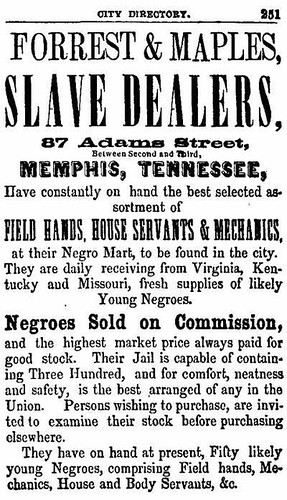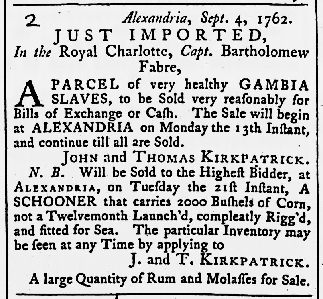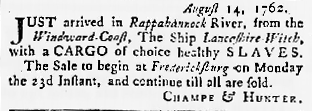xoxodede
Superstar
In this thread - we will be discussing the Slave Traders -- those personally responsible for selling our ancestors -- once they hit this land.
Isaac Franklin and John Armfield: Franklin and Armfield Office was started in 1828 by Isaac Franklin and John Armfield. The office was known to have been the largest slave trading firm in the antebellum south. At its height in the 1830s, the firm transported between 1,000 and 1,200 slaves from Alexandria to New Orleans each year. Source
Nathan Bedford Forrest: He made his pre and post Civil War fortunes off of Black bodies.
Slave trading was not for the morally sensitive, but Forrest stood out even among slave-traders in his oppression of his human property. In January of 1860 his “Slave Mart” collapsed in a heavy rain, “burying beneath its ruins six valuable slaves,” killing at least two. He was also certainly the source of an article published in January of 1859 claiming that he was in possession of a daughter of “Fred Douglass.” Emphasizing that she was “of the class known among the dealers as a ‘likely girl,’” Forrest cruelly noted her vulnerability to rape. The article called out Douglass for hypocrisy in failing to purchase her. We can assume that she was not actually a daughter of Douglass. Chronicling America is in the Home Journal (Winchester, Tennessee), on January 20, 1859, “Fred Douglass’ Daughter for Sale.” Source
Austin Woolfolk: One of the most prominent of these controversial figures was a Georgian named Austin Woolfolk who dominated the border state trade from his headquarters in Baltimore during the 1820's and 1830's. Source He became notorious for selling Frederick Douglass's aunt, and for assaulting Benjamin Lundy after the latter had criticized him.
Joseph Bruin of Bruin & Hill/Bruin's Jail: Bruin, along with his partner Henry P. Hill, operated Bruin & Hill in Alexandria with a slave jail located on Duke Street that still stands today. Bruin gained his notoriety in Harriet Beecher Stowe’s Uncle Tom’s Cabin because of his involvement in incidents following the attempted slave escape aboard the Pearl in April 1848. Read more here: http://www.virginiamemory.com/blogs/out_of_the_box/2013/12/04/12-years-a-slave/
Bernard Kindig: was known for selling disease and wounded aka "defective"slaves. Bernard Kendig, a slave trader in New Orleans, landed in court thirteen times in ten years. Four times there was no verdict in the case, once he was found not guilty, three times he was found guilty of fraud, three times he was found to have sold defective slaves, and twice he sold stolen slaves. Source: Slavery and Medicine: Enslavement and Medical Practices in Antebellum Louisiana
Hope Hull Slatter/Shadrach F. Slatter: native of Clinton, Georgia, became a leading slave dealers in Baltimore after the era of Woolfolk. With a building centrally located on Pratt Street, Slatter used trains to transport slaves to Georgia and boats to transport others to New Orleans. Baltimore was a large slave trading location. Source
John Brown (Rhode Island) and his brothers: Sons of Providence: The Brown Brothers, the Slave Trade, and the American Revolution
Nathaniel Gordon: was the first and only slave trader in the U.S. to be tried, convicted, and executed "for being engaged in the Slave Trade," under the Piracy Law of 1820.
Hector Davis: One of Richmond’s large-scale traders, selling people from the 1840s until just before his death in 1863. Source
Thomas Ryan and James Marsh of Charleston: Ryan's Mart originally consisted of a closed lot with three structures— a four-story barrac00n or slave jail, a kitchen, and a morgue or "dead house."
James Bowie
Hatcher & McGehee Slave Depot. Slave trading in Columbus, Georgia
John Montmollin and Alexander Bryan of Savannah's Montmollin Building
Lafitte Barthe & Co.
T. C. Weatherly
Austin Moses
Pickett & Williamson
If you want to see who the more successful and well-known traders in the South were - I would recommend looking at Slave Ship Port Manifest like U.S., Southeast Coastwise Inward and Outward Slave Manifests, 1790-1860 and the Port of Savannah Slave Manifests, 1790–1860 and Mobile.
Some resourceful books on the topic are:
Speculators and Slaves: Masters, Traders, and Slaves in the Old South
The Chattel Principle: Internal Slave Trades in the Americas
The Price for Their Pound of Flesh: The Value of the Enslaved, from Womb to Grave, in the Building of a Nation
Soul by Soul: Life Inside the Antebellum Slave Market
Sold Down the River: Slavery in the Lower Chattahoochee. Valley of Alabama and Georgia
A Troublesome Commerce: The Transformation of the Interstate Slave Trade
Isaac Franklin and John Armfield: Franklin and Armfield Office was started in 1828 by Isaac Franklin and John Armfield. The office was known to have been the largest slave trading firm in the antebellum south. At its height in the 1830s, the firm transported between 1,000 and 1,200 slaves from Alexandria to New Orleans each year. Source
Nathan Bedford Forrest: He made his pre and post Civil War fortunes off of Black bodies.
Slave trading was not for the morally sensitive, but Forrest stood out even among slave-traders in his oppression of his human property. In January of 1860 his “Slave Mart” collapsed in a heavy rain, “burying beneath its ruins six valuable slaves,” killing at least two. He was also certainly the source of an article published in January of 1859 claiming that he was in possession of a daughter of “Fred Douglass.” Emphasizing that she was “of the class known among the dealers as a ‘likely girl,’” Forrest cruelly noted her vulnerability to rape. The article called out Douglass for hypocrisy in failing to purchase her. We can assume that she was not actually a daughter of Douglass. Chronicling America is in the Home Journal (Winchester, Tennessee), on January 20, 1859, “Fred Douglass’ Daughter for Sale.” Source
Austin Woolfolk: One of the most prominent of these controversial figures was a Georgian named Austin Woolfolk who dominated the border state trade from his headquarters in Baltimore during the 1820's and 1830's. Source He became notorious for selling Frederick Douglass's aunt, and for assaulting Benjamin Lundy after the latter had criticized him.
Joseph Bruin of Bruin & Hill/Bruin's Jail: Bruin, along with his partner Henry P. Hill, operated Bruin & Hill in Alexandria with a slave jail located on Duke Street that still stands today. Bruin gained his notoriety in Harriet Beecher Stowe’s Uncle Tom’s Cabin because of his involvement in incidents following the attempted slave escape aboard the Pearl in April 1848. Read more here: http://www.virginiamemory.com/blogs/out_of_the_box/2013/12/04/12-years-a-slave/
Bernard Kindig: was known for selling disease and wounded aka "defective"slaves. Bernard Kendig, a slave trader in New Orleans, landed in court thirteen times in ten years. Four times there was no verdict in the case, once he was found not guilty, three times he was found guilty of fraud, three times he was found to have sold defective slaves, and twice he sold stolen slaves. Source: Slavery and Medicine: Enslavement and Medical Practices in Antebellum Louisiana
Hope Hull Slatter/Shadrach F. Slatter: native of Clinton, Georgia, became a leading slave dealers in Baltimore after the era of Woolfolk. With a building centrally located on Pratt Street, Slatter used trains to transport slaves to Georgia and boats to transport others to New Orleans. Baltimore was a large slave trading location. Source
John Brown (Rhode Island) and his brothers: Sons of Providence: The Brown Brothers, the Slave Trade, and the American Revolution
Nathaniel Gordon: was the first and only slave trader in the U.S. to be tried, convicted, and executed "for being engaged in the Slave Trade," under the Piracy Law of 1820.
Hector Davis: One of Richmond’s large-scale traders, selling people from the 1840s until just before his death in 1863. Source
Thomas Ryan and James Marsh of Charleston: Ryan's Mart originally consisted of a closed lot with three structures— a four-story barrac00n or slave jail, a kitchen, and a morgue or "dead house."
James Bowie
Hatcher & McGehee Slave Depot. Slave trading in Columbus, Georgia
John Montmollin and Alexander Bryan of Savannah's Montmollin Building
Lafitte Barthe & Co.
T. C. Weatherly
Austin Moses
Pickett & Williamson
If you want to see who the more successful and well-known traders in the South were - I would recommend looking at Slave Ship Port Manifest like U.S., Southeast Coastwise Inward and Outward Slave Manifests, 1790-1860 and the Port of Savannah Slave Manifests, 1790–1860 and Mobile.
Some resourceful books on the topic are:
Speculators and Slaves: Masters, Traders, and Slaves in the Old South
The Chattel Principle: Internal Slave Trades in the Americas
The Price for Their Pound of Flesh: The Value of the Enslaved, from Womb to Grave, in the Building of a Nation
Soul by Soul: Life Inside the Antebellum Slave Market
Sold Down the River: Slavery in the Lower Chattahoochee. Valley of Alabama and Georgia
A Troublesome Commerce: The Transformation of the Interstate Slave Trade










